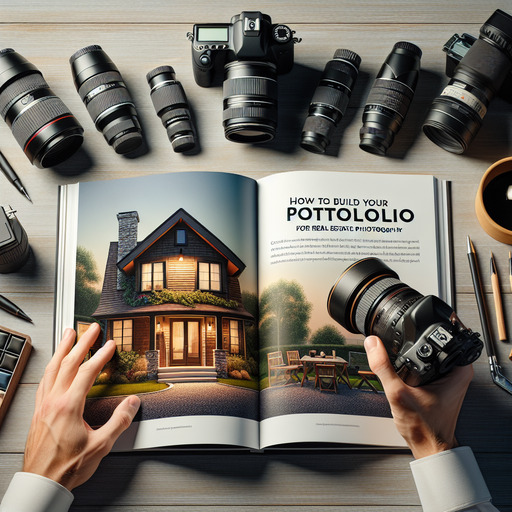
-
Table of Contents
Elevate your real estate photography career by building a stunning portfolio that showcases your skills and attracts clients. Learn the essential steps and tips to create a compelling portfolio that stands out in the competitive market. Start building your portfolio now!
Introduction
Building a portfolio for real estate photography involves showcasing your skills and expertise in capturing properties in their best light. A well-crafted portfolio not only highlights your technical abilities but also demonstrates your understanding of composition, lighting, and the unique aspects of real estate photography. To create an impressive portfolio, start by photographing a variety of properties, including residential, commercial, and luxury homes. Focus on capturing high-quality images that emphasize space, light, and architectural details. Organize your portfolio in a visually appealing manner, either through a professional website or a high-quality printed book. Include a mix of wide-angle shots, detailed close-ups, and exterior images to provide a comprehensive view of your capabilities. Additionally, consider adding before-and-after photos to showcase your editing skills. Testimonials from satisfied clients and a brief biography outlining your experience and approach can further enhance your portfolio. By presenting a diverse and polished collection of your best work, you can attract potential clients and establish yourself as a skilled real estate photographer.
How to Build a Portfolio for Real Estate Photography: Essential Tips and Techniques
Building a portfolio for real estate photography is a crucial step for any aspiring photographer looking to break into the industry. A well-curated portfolio not only showcases your skills but also serves as a testament to your professionalism and attention to detail. To begin with, understanding the importance of high-quality images cannot be overstated. Real estate photography is all about capturing the essence of a property, highlighting its best features, and making it appealing to potential buyers or renters. Therefore, investing in a good camera and lens is essential. A full-frame DSLR or mirrorless camera paired with a wide-angle lens will help you capture expansive shots that make rooms appear larger and more inviting.
Once you have the right equipment, the next step is to practice. Start by photographing your own home or the homes of friends and family. This will not only help you get comfortable with your gear but also allow you to experiment with different angles, lighting conditions, and compositions. As you gain confidence, consider reaching out to local real estate agents or property managers who might be willing to let you photograph their listings in exchange for free images. This can be a win-win situation, as it provides you with valuable experience and content for your portfolio while offering them professional-quality photos at no cost.
Lighting is another critical aspect of real estate photography. Natural light is your best friend, so aim to shoot during the day when rooms are well-lit. Open curtains and blinds to let in as much light as possible, and consider using a tripod to stabilize your camera for longer exposures if needed. In situations where natural light is insufficient, use external flashes or continuous lighting to brighten up the space. Proper lighting can make a significant difference in the quality of your photos, making them look more professional and appealing.
Editing is the final step in creating stunning real estate photos. Post-processing software like Adobe Lightroom or Photoshop can help you enhance your images by adjusting exposure, contrast, and color balance. Be careful not to over-edit, as this can make your photos look unrealistic. The goal is to present the property in the best possible light while maintaining a natural and authentic appearance. Consistency in editing style is also important, as it gives your portfolio a cohesive look and feel.
As you build your portfolio, it’s essential to showcase a variety of properties. Include different types of homes, such as apartments, single-family houses, and luxury estates, to demonstrate your versatility. Highlight various aspects of each property, from exterior shots to interior details, to give potential clients a comprehensive view of your capabilities. Additionally, consider creating a dedicated website or online gallery to display your work. This not only makes it easy for clients to view your portfolio but also adds a level of professionalism to your brand.
Networking and marketing are also vital components of building a successful real estate photography portfolio. Attend industry events, join photography and real estate groups on social media, and connect with professionals in the field. Word of mouth and referrals can be powerful tools in growing your business. Moreover, don’t underestimate the value of client testimonials. Positive feedback from satisfied clients can significantly enhance your credibility and attract new business.
In conclusion, building a portfolio for real estate photography requires a combination of technical skills, creativity, and strategic marketing. By investing in quality equipment, practicing regularly, mastering lighting and editing techniques, showcasing a diverse range of properties, and actively networking, you can create a compelling portfolio that sets you apart in the competitive real estate market.
Q&A
1. **Question:** What are the key steps to building a portfolio for real estate photography?
**Answer:**
– **Start with Practice Shoots:** Photograph friends’ or family members’ homes to build initial content.
– **Focus on Quality:** Ensure high-quality images with proper lighting, composition, and editing.
– **Showcase Variety:** Include different types of properties (e.g., apartments, houses, commercial spaces).
– **Highlight Key Features:** Emphasize unique architectural details and selling points of each property.
– **Create an Online Presence:** Build a professional website or use platforms like Instagram and LinkedIn to display your work.
– **Network with Realtors:** Connect with real estate agents and offer to shoot properties for free or at a discounted rate initially.
– **Gather Testimonials:** Collect reviews and testimonials from satisfied clients to add credibility.
– **Update Regularly:** Continuously update your portfolio with new and improved work to reflect your growth and current style.